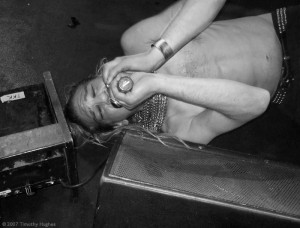The megapixel race is over!
I’d like to write a little bit about compact cameras and the optimum sensor resolution in digital cameras (point and shoot and DSLR). To save you, the weblog reader precious time, my quick answer is 8 mp for compacts and 16 mp for DSLRs. I’ve come up with this crackpot theory using two major factors. 1) The amount of resolution (megapixels) the average and above average photographer needs to print at the largest size they will ever possibly use. 2) The maximum amount of pixels camera manufacturers are able to employ on a sensor while maintaining low image noise at high ISOs.

Groovie Mann at The Annex, 2007. Camera: Fuji FinePix F30, 800 ISO, 1/60 sec. f/2.8, focal length 8mm, on camera flash.
My compact camera is the sought after Fujifilm F30. It’s a very durable little pocket camera with a 6.3 megapixel Super CCD sensor and excellent image results in low-light situations up to 800 ISO. It gets great results because Fuji used a large sensor (by point and shoot standards) and did not try to cram too many pixels into the chip design. The end result is a very publishable image, taken under less than ideal light conditions like a restaurant or nightclub. 
Jodi at the Cardinal Bar, 2008. Camera: Fuji FinePix F30, 800 ISO, 1/60 sec. f/2.8, focal length 8mm, on camera flash.
Newer compacts are now using dual image stabilization (awesome) and obviously have more features and better performance in general. However, from what I’ve seen, the 12 and 14 megapixel sensors found on today’s pocket cameras do not produce clean images at high ISOs! Seriously, if your camera cannot produce a clean image at 800 ISO or higher, the sensor is shit in my eyes. The only reason manufacturers keep bumping up resolution is because higher megapixel numbers sell more cameras.
Take a look at the image noise test results for a high-end camera like the ultra-sexy Leica M8 and I think you’ll find that 1250 ISO does not generate a clean enough image to publish under normal circumstances. Therein lies our problem, current generation sensors (on compact cameras) simply do not perform well-enough to crank out 10 or 14 megapixels of resolution. My solution is for manufactures to cap the resolution on compacts to 8 megapixels-plenty to run a full-page photo in a magazine or newspaper and 30x the resolution needed to post an image on facebook or whatever.
Fortunately for us, the sensors in DSLRs are larger and do far better in low light situations. My Canon 5D is 12.8 megapixels. It’s really a great, great camera body but… obviously DSLR bodies gotten more advanced. The 5D MKII is 21 megapixels. Very impressive in marketing materials for Canon, but is that much resolution really needed? In short the answer is no. Read: with careful post-production, billboards have been shot with 6+ megapixel cameras. My next camera body will likely be a 5D MKII, but I will be doing much of my professional work shooting at a reduced resolution of 10 mp SRAW simply because the full-res. 21 mp files will tie up too many resources. From the continuous shooting frame speed, to CF card space, to hard drive space, and time spent editing in post-production, it’s just far more data than one needs for anything other than a 6 foot or greater fine art print. That’s my rant, Timothy Hughes signing off.

One Comment